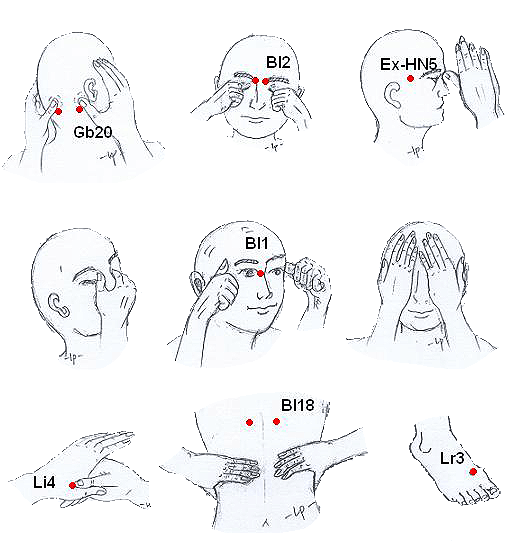
Acupressure for Menstrual Cramps
Menstrual cramps affect more than 50 percent of women worldwide and more than 15 percent suffer from severe cramping that limits physical activity. The process of acupressure, which involves applying pressure to spots on the body known as acupoints that correspond to junctions of physiological systems, can reduce the pain associated with menstrual cramps.
What Kind of Acupressure Relieves Menstrual Cramping?
Women suffering from menstrual cramps can use a variety of acupressure points to relieve pain and other symptoms. The basic technique is to locate the acupressure point and apply pressure using the tip of the finger, the knuckle or a soft rounded object, such as a pencil eraser. Pressure should be applied for 1 to 3 minutes, but care should be taken to ensure that the fingers remain comfortable while applying pressure.
Acupoints are named for the part of the body they correspond to rather than the part of the body where the acupoint is located. For instance, an acupoint commonly used for menstrual cramping is “Three Yin Intersection” (the Chinese term for which is San Yin Jiao), which is located behind the calf, about three inches from the ankle. The acupoint is also known as SP-6 or “Spleen 6” because it is part of a pathway that Chinese medicine specialists believe includes the spleen.
Other acupoints known to help with menstrual cramping include:
* The Sea of Energy (Qi Hai) located two finger widths below the belly button. Also called Conception Vessel (CV) 6. The CV-6 point is also used to treat digestion problems, edema, and bloating.
* The Inner Pass (Nei Guan) located approximately 2 inches from the wrist on the inner arm. Also known as Pericardium (PC) 6. This point has also been demonstrated, in clinical studies, to relieve vomiting and abdominal problems during pregnancy.
* The Union Valley (He Gu) located in the webbing between the thumb and the forefinger. Also known as Large Intestine (LI) 4. This point is believed to aid in any problem involving chronic pain.
* The Wind Pool (Feng Chi) located at the rear of the skull about two to three inches from the ear. Also called Gall Bladder (GB) 20. The GB-20 point is often prescribed for headache and hypertension.
* The Leg Three Li (Zu San Li) located about one finger width from the juncture of the tibia on the outside of the leg. Also known as Stomach (ST) 36. The ST-36 point is also used to relieve any other issue involving the stomach or spleen.
* The Middle Gate (Mu Guan) located about one finger width from the wrist crease on the palm. This is an extra point discovered by Master Tong, although it is on the Pericardium (PC) pathway. Mu Guan is also used for heel pain.
What is Acupressure?
Acupressure is a part of Traditional Chinese Medicine, which includes acupuncture, moxibustion, and Chinese Herbal Medicine. Medical manuscripts and other artifacts indicate that Chinese healers have been using acupressure for at least 3000 years to treat ailments from fractured bones to depression.
There are two views on how acupressure works. In traditional Chinese medicine, the body is believed to be composed of channels of energy, known as meridians, that connect all the body’s organs and other components into a single system. It is believed that by applying pressure to certain points (acupressure) or piercing the points with needles (acupuncture), the flow of energy (qi) is altered. These changes in energy result in corresponding effects on the body.
Research indicates that acupuncture and acupressure can alter levels of neurochemicals, which are chemicals that flow through the bloodstream and regulate a variety of bodily processes. It is also possible that by altering body chemistry, acupressure can have an effect on a variety of ailments.
Experiments have indicated that acupressure is highly effective at relieving tension and stress. It has also been shown to have significant positive effects on pain and circulatory problems. Some medical professionals have suggested that by relieving stress in one part of the body, acupressure may have peripheral effects on other parts of the body, including lessening sensations of pain.
What Causes Menstrual Cramps?
Menstrual cramping, known as “dysmenorrhea,” is a painful affliction that accompanies menstruation in approximately 50 percent of women. As the lining of the uterus (endometrium) begins breaking down during menstruation, dying tissues release hormones called prostaglandins into the blood stream. Prostaglandins cause the muscles of the uterus to contract as they force the endometrial material through the cervix and the vagina.
As pieces of the uterine lining pass through the cervix, pressure from contracting muscles may cause pain in the uterus. Most menstrual cramps last from 15 to 90 seconds and generally start in the lower abdomen and pelvis. Pain can be continuous or periodic and usually lasts for 2-4 days.
The intensity of menstrual cramping is related to the concentration of hormones and other neurochemicals in the blood. Women with narrow cervical canals also tend to suffer from more painful cramping. The cramps endured by some women during menstruation are similar to those experienced by women during early stages of childbirth.
While traditional medicines and pain relievers are often used to treat the symptoms of menstrual cramps, some women prefer a more naturalistic approach. Certain types of exercise, dietary changes, and herbal remedies have all been developed to address cramping. As information about Traditional Chinese Medicine has become more widely available, a number of women have turned to treatments like acupuncture and acupressure as potential solutions to menstrual cramps.










